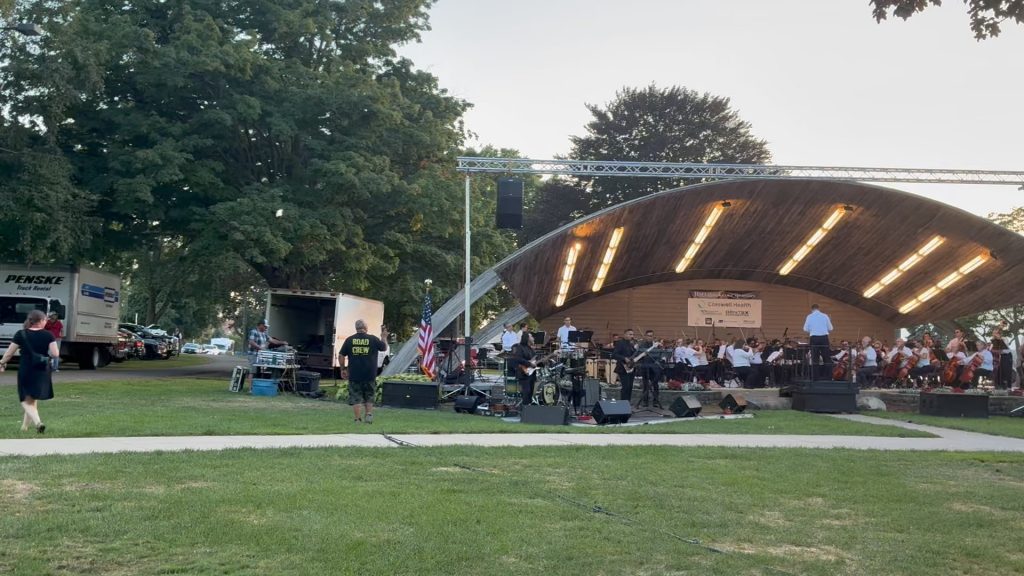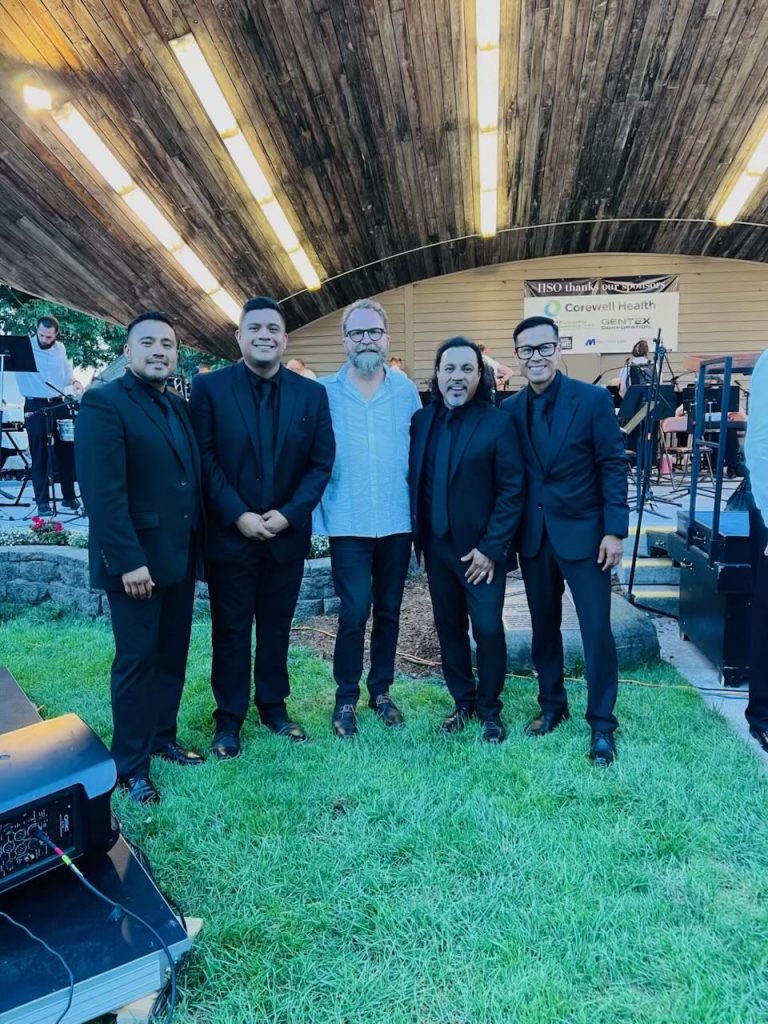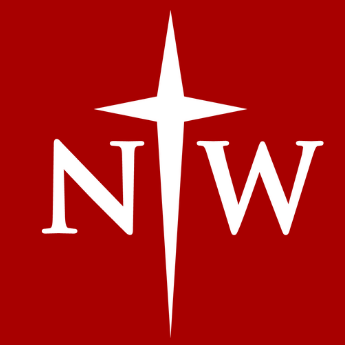It’s so much fun to work with friends! In this case, my friend Carlos Colón commissioned me to write an arrangement of “Mary’s Song,” a song written by another friend, Wendell Kimbrough. This beautiful performance was recorded at a rehearsal for a chapel service at Baylor University.
Category: Commissions
Grandfare
This summer, I was commissioned by the Grand Rapids musicians’ union to compose a fanfare for our 120th anniversary. The parameters were: a 2-minute (120 seconds–see what they did there?) fanfare scored for a mixed ensemble of brass, winds, and percussion not to exceed the instrumentation of Aaron Copland’s “Inaugural Fanfare,” which would also be on the program. I only had a month to go from blank page to completed score and parts, so I knew I had to get busy.
But first: what is a fanfare?
Intuitively, I understood a fanfare to be a festive, trumpety thing, but I started to second-guess myself. Was there a secret recipe that everyone knew but me? (I’ve been composing for forty years, and I am still susceptible to impostor syndrome.) After a good deal of research, I confirmed that a fanfare is, indeed, a festive, trumpety thing. It has no precise definition, but there are plenty of examples: Copland’s “Fanfare for the Common Man” is something of a gold standard, as is John Williams’ “Olympic Fanfare and Theme.” One of my personal favorites is Leoš Janáček’s “Sinfonietta.”
The challenge was to compose something regal and courageous, immediately accessible to listeners, playable by performers with a half hour rehearsal, and that says everything it needs to say in a very short time.
I gravitated toward a more-or-less tonal palette, but kept it from being obvious or saccharine by using lots of stacked fifths/fourths (for openness) and non-harmonic tones (for bite). Of course, I relied heavily on the trumpets, but every section is featured at some point. I also had a ton of fun with the percussion, including Glockenspiel, Xylophone, Tubular Bells, Brake Drum, Crotales, China Cymbal, Cabasa, Vibraphone, Tam-tam, Suspended Cymbal, Crash Cymbal, and Drum Set. Finally, I played with style. The GR music union is made up of musicians of all genres: classical, blues, jazz, rock, etc. So, I used drum set to establish a pop groove in the middle of the fanfare, with jazz style voicings on top of it.
I was really pleased with how it turned out–a tasty little slice of musical cake.
HSU MUU: Inevitable Adiós
The final arrangement for the Holland Symphony Orchestra’s “Music Unites Us” concert with Grupo Super Nova was a ballad called “Inevitable Adiós.” It is gorgeous and heartbreaking.
When Christian, the songwriter, first sent me this, I responded, “I don’t understand half of the Spanish, and I was still getting choked up!” With a song like this, the best thing to do is just stay out of the way. Let the song speak for itself; simply support and enhance what is already in the music. I did that with lush lower strings, regal horns, soaring violin lines, harp, and lots of cymbal rolls.
Of course, I needed to let the orchestra come to the foreground at some point. I did this with an oboe solo, a flugelhorn solo, and a trumpet/trombone duet. Just enough of a break to leave us wanting more.
I’m usually not one for modulations. They are so often used as a cheap way of inflating energy back into a mediocre song that I normally stay clear of them. But I made an exception here. I let the song wind down as if it were ending, but instead of the quiet tag of “Inevitable adiós” that we expect–BAM!–a sudden modulation into a new key with full orchestra. It’s glorious, if I don’t say so myself.
Below is video of me accompanying Christian on guitar at the concert.
HSO MUU: Escucha
The next arrangement for Grupo Super Nova and the Holland Symphony Orchestra was “Escucha.” This song, too, is in an upbeat Cumbia dance style, but the lyrics are poignant: “Listen! I want you to pay attention, just in case today is our last day together: I love you like I have never loved before.”
This arrangement is further outside the box than the others. I ask the violins to strum their instruments like ukeleles and play a melody on one string with one finger (to match the portamento of the synth line). Later is a duet between electric guitar and electric violin. Then I ask the orchestra to sing background vocals. All of these stretch the musicians out of their comfort zones, but since we had worked together previously, I decided there was enough trust for them to try these unusual effects with a minimum of grumbling.
One of my favorite sections is when all the motion stops and Hector sings a quiet refrain in English. I didn’t want the English-speaking audience to miss the poignant message of the lyrics. Too, a short silence makes what follows sound even more energetic.
I should make a note about how I created these demos. I use Dorico for my notation software. To make a demo of the arrangement, I play Dorico through orchestral playback software called NotePerformer. NP is unique in that it interprets the score as orchestral musicians would play it, with articulations, blend, and reverb as they would happen in an actual performance. (Who says AI is bad?) From there, I load my orchestral arrangement and Grupo’s original recording into Logic Pro. After a bit of tempo matching and splicing I can produce a decent demo of how the final performance might sound. This is really important when trying to get buy in from both note-readers and ear-performers. It allowed everyone walk into rehearsal with a very good idea of how it would sound.
Below are a few snippets of video from the concert. There aren’t a lot of composers who can say people dance to their orchestrations!

I recently wrote three new arrangements for the Holland Symphony Orchestra’s “Music Unites Us” concert on August 9, 2025. In this outdoor concert, Grupo Super Nova, a Mexican Cumbia group from Holland, performed their original songs with the orchestra. My next three posts will be the arrangements from that concert.

The original “Lo mejor” (link below) keeps up a mid-tempo dance groove throughout. In each of these songs, I was looking for ways to create a dialogue between band and orchestra, rather than keeping the orchestra in a purely accompaniment role. So, on this song, I decided to begin with an extended, dramatic introduction before it kicked into its dance groove. Once the beat drops, the orchestra plays an accompaniment role, until…
Surprise! It’s a tuba solo. In the Mexican Banda style, tubas play a prominent role. I decided to tip my hat to that tradition by starting the mid-song breakdown with a tuba solo. Then comes a long build, beginning with the violin, moving through the strings, and then joined by all the bass instruments. After a quick recap of the chorus, the song concludes.
Sadly, I didn’t get a good video recording of the event. You will have to be satisfied with a demo of an early draft of the score. Email me if you’d like to take a look at the score.
From 2000 to 2005, I worked at Northwestern College in Iowa, teaching music and worship in the music department, and leading chapel worship and overseeing worship teams for campus ministries.

In my second year there, a new president was inaugurated, and I was commissioned to compose a piece for the ceremony. I hadn’t thought about it much in the few decades since, but I recently found a recording from the inauguration and decided to clean it up and post it here.
I had forgotten how much I like it!
The lyrics are adapted from Psalm 67–a perfect Psalm of thanksgiving for a fall worship ceremony in the heartland of America. The meter is 7/8 throughout. I never strayed from a 2+2+3 rhythm; still, the choir hated me for the odd meter! The rhythmic vitality really drives the piece; it feels exciting and exuberant. The harmonic style is–I don’t know what to call it–pan modal? But I like it. There is a lot of bite in the harmonies, but they’re not so complicated the choir can’t find their notes or it leaves the audience scratching their heads.
It feels like it was an important step forward in my composing.
I haven’t posted to my blog in a month, but that doesn’t mean I’ve been slacking off. No, indeed! I’ve been working on some big commissioned projects and soon-to-be-released albums. But here’s a recent arrangement I can share with you.

My good friend Carlos Colón wrote a beautiful song based on St. Athanasius’ On the Incarnation, called “Prince of Peace.” He asked me to write strings to go with the choral anthem and then he recorded it with a group of exceptional musicians.
Most of the time, I follow my own artistic impulses, but it is really satisfying to help someone else achieve their musical vision–especially when it turns out so beautifully!
You can request the score at Carlos’ website.
I forgot to post this to my blog when I completed it in December!
My alma mater congregation, Church of the Servant, reached out to me last year about their O Antiphon service.* They had been using various musical resources and wanted to commission a brand new setting of all seven “O” texts. I set to work writing new texts based on the original Latin verses and composing an original melody.
Since the O Antiphons are traditionally associated with the Magnificat, I decided to tie all seven verses together with Mary’s song of praise, turning her words into a group response: “Our Souls will Magnify the Lord.” It is a pentatonic (five-note) melody that never seems to come to rest because it begins on the second scale degree and ends on the third. Let me put that in normal person language: the melody has a mystical, elusive quality that reflects the tone of the text and worship service.
This should have been a simple one-and-done seven-verse hymn, but as I continued to work on it, I imagined more sonic textures. By the time I was done I had written a 60 page score for choir, flute, alto recorder, violin, viola, bass, and piano. Feel free to follow along in the scrolling-score video above.
*If you’re not familiar with this Advent tradition, the O Antiphons are seven songs, each beginning with “O” and then addressing the coming Savior with a title like “O Wisdom” or “O Root of Jesse.” You may know them in one of their most popular forms, the hymn “O Come, O Come, Emmanuel.”
Cannon
I was commissioned to compose a new piece for The Northwest Iowa Christian Schools String Orchestra Festival. The result is Cannon, which premiered on October 31, 2024.
It was a lovely performance featuring over 100 student string players. Here are the notes about the piece that appeared in the program:
I’ve always joked that I continue composing because I want to have my Pachelbel’s “Canon.” Though Pachelbel wrote hundreds of pieces, most of us only know his ubiquitous “Canon in D.” Not bad for a “one hit wonder”! As an homage to Pachelbel, I named my piece “Cannon in D Minor” and began composing. However, I soon ran into a problem: the orchestra would sound a lot better in a key like G or D. I transposed my draft to G and shortened the title to “Cannon” (this music is explosive in any key!) and got back to work.
What emerged is a composition that is full of rhythmic energy and surprises. The piece begins with a bang, a fanfare that sets the tone for what is to come. Suddenly, the bombast stops and a stately canon begins. (You’ll remember that a canon is another word for round, where a musical theme is repeated in each section. Think “Row, Row, Row Your Boat.”) After a brief reappearance of the fanfare, we enter an extended rhythmic section that has hints of Irish Jigs, African rhythms, and Rock and Roll. Once again, we hit the brakes for a canon, but this time it is a quote of Pachelbel’s “Canon”—with a twist. The orchestra has barely finished the first eight measures of Pachelbel’s theme when a solo violin interjects a theme of its own—a double-canon mash up of Pachelbel and Scheer that takes us to the final fanfare.
Astute music connoisseurs will notice a unique feature of the “Cannon” orchestra: the addition of Acoustic Guitar, Piano, Percussion, and Drum Set. The idea of adding a rhythm section was suggested after the conductors heard some songs I had written for the St. Sinner Orchestra, a symphonic rock group I lead. I quickly agreed, being a composer who loves combining styles and timbres in fresh ways.
Who knows? Maybe “Cannon” will be my Pachelbel’s “Canon”!
A friend sent me this lovely Chinese communion song and a literal translation by a missionary/translator. There is no better way to procrastinate than to translate, arrange, and record a new global hymn, so I set to work!
The key to translating a song is to get the spirit of the song, rather than just the words. Is the song highbrow or heartfelt? What is the rhyme scheme in the original language–or is there one? Is the music simple or complicated? All these questions come into play when “transplanting” a song from one culture to another.
“One with the Lord” is a simple chorus with no surprises or sophisticated nuances. And yet, in its simplicity it is lovely and immensely singable. You’ll notice that the lyrics are all in first person. I’m not always a fan of “Jesus and me” communion songs, but I’ll make an exception for this authentic expression of personal prayer. One of the difficulties was that meter is 6.6.6.4. With lines that short–and distinct breaks between each line–it’s hard to fit all of the Chinese lyric’s meaning into so few English syllables. In cases like this, I always choose singability over correct grammar.
I would love to hear from anyone who has sung the song in its original language or know where the song originated!
1. Christ gave himself for me–
body and blood for me.
The bread and cup I see
come from our Lord.
Christ broke the bread of life,
poured out salvation’s wine.
I eat and drink and I’m
one with the Lord.
2. I have been crucified.
My sin is dead in Christ.
And yet I am alive–
alive for God.
I am made new in Christ.
Darkness gives way to light.
Christ has become my life.
Glory to God!
